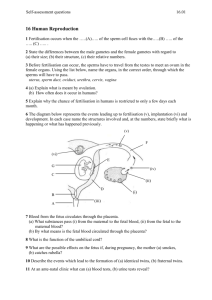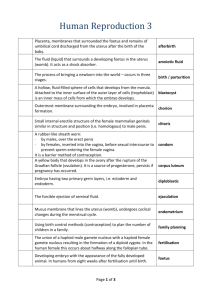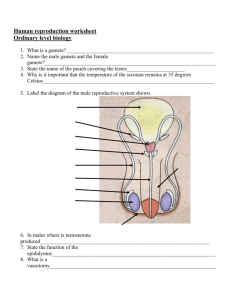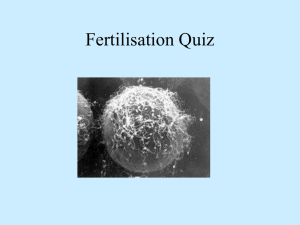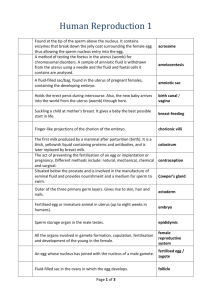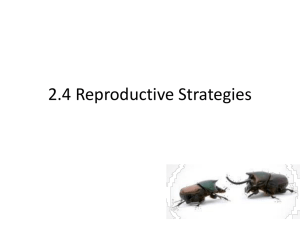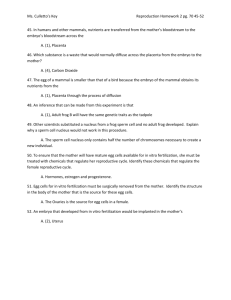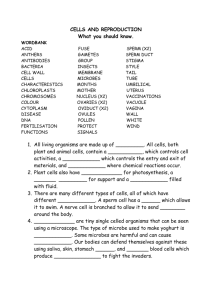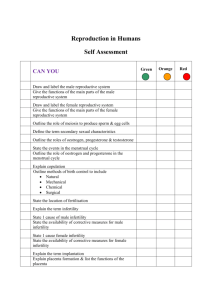Life Sciences x
advertisement
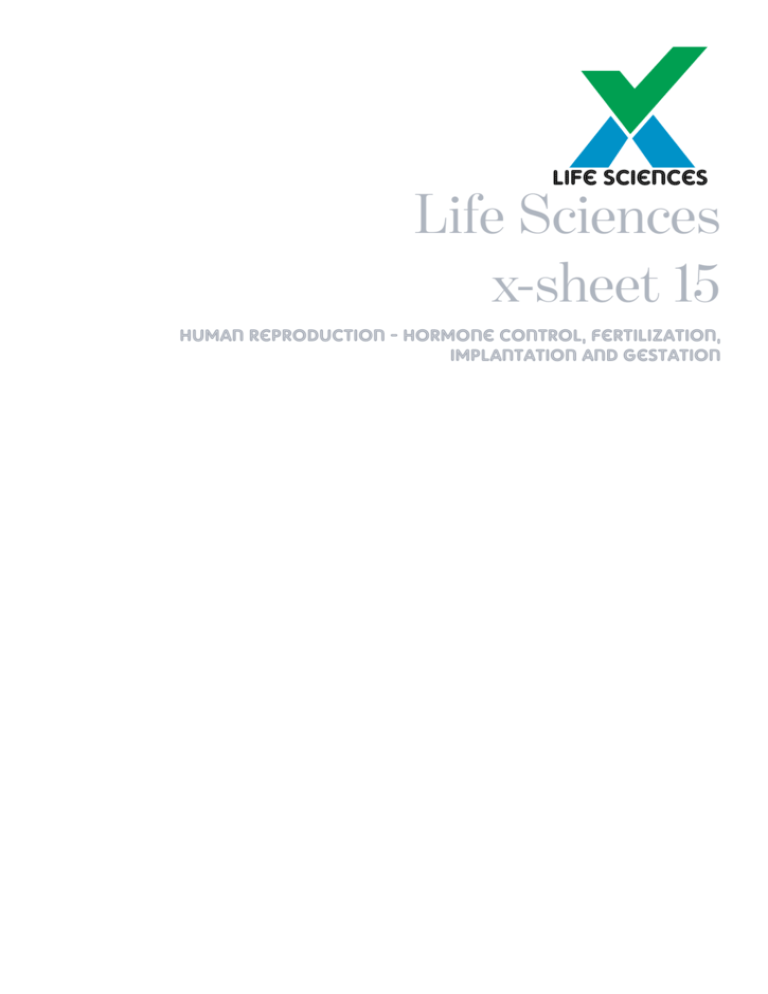
Life Sciences Life Sciences x-sheet 15 Human Reproduction - Hormone Control, Fertilization, Implantation and Gestation HUMAN REPRODUCTION - HORMONE CONTROL Human Reproduction - Hormone Control, Fertilization, Implantation and Gestation Terminology & definitions Corpus luteum: structure that results when the Graafian follicle releases the egg cell during ovulation. The corpus luteum also secretes progesterone if the egg is fertilised. Follicle stimulating hormone (FSH): produced by the anterior lobe of the pituitary gland and causes the maturing of the follicle surrounding the oocyte it stimulates the supply of nutrients. Gametogenesis: the formation of gametes. Gonadotrophic hormones: hormones secreted by the pituitary gland to control reproductive cycles and processes in males and females. Luteinising hormone (LH): a hormone produced by the anterior lobe of the pituitary gland that stimulates the release of oestrogen into the bloodstream which causes ovulation Menstrual cycle: begins with menstruation and continues for 28 days. It is controlled by hormones to co-ordinate the release of the mature egg cell with the readiness of the uterus for implantation, if fertilisation takes place. Menstruation: when there is no fertilisation, the lining of the uterus is shed to prepare for the next cycle. This results in a flow of blood that lasts for approximately 5 days. Oestrogen: a hormone secreted by the ovaries, causing ovulation. Oogenesis: the process to produce haploid egg cells in the follicles of the ovary. Progesterone: a hormone secreted by the corpus luteum when the egg cell is fertilised to ensure pregnancy. Copulation: the insertion of the male reproductive organ into the female reproductive organ to transfer sperm to the egg cell. Fertilisation: fusion of two haploid gametes (sperm cell and egg cell) to form a diploid zygote. Internal fertilisation: fertilisation that occurs inside the body of the female, inside the Fallopian tube Pregnancy: is the development of the embryo inside the uterus. It can also be called gestation. Vasodilation: is the increase of blood volume causing the penis to become erect. The erect penal tissue closes the valve of the urethra to prevent the possibility of urination during ejaculation of the sperm cells. Amnion: fluid-filled sac where the embryo develops in the uterus. Amniotic fluid: fluid surrounding the foetus in the amnion. Placenta: a structure that grows from the wall of the uterus to prevent direct contact of the mother’s blood with that of the foetus. Umbilical cord: links the placenta to the developing foetus. Key Concepts / Diagrams Hormonal control of Oogenesis • Hormones control the 28 day menstruation cycle. Usually only one egg is released per cycle. Should both ovaries release an egg cell and both are fertilised, the result would be paternal twins (unidentical). The menstruation cycle affects the ovaries and the uterus. • Gonadotrophin releasing hormone (GnRH) stimulates the anterior pituitary gland to release follicle stimulating hormone (FSH) into the blood. • FSH is transported to the ovaries (target organ) where it stimulates the development of the follicle. • Granulosa cells in the developing follicle produce oestrogen. Oestrogen has two target organs namely the uterus and the anterior pituitary gland. o Oestrogen causes the development of the endometrium in the uterus to prepare it for pregnancy. o Oestrogen inhibits the secretion of FSH by the anterior pituitary gland so that no further follicles are produced during the pregnancy. High oestrogen levels will trigger the secretion of luteinising hormone (LH). 123 Life Sciences X-Sheets HUMAN REPRODUCTION - HORMONE CONTROL Life Sciences Life Sciences • LH is released into the blood and is transported to the ovary, causing ovulation. LH stimulates the Graafian follicle to develop into the corpus luteum. • The corpus luteum secretes oestrogen and progesterone. o Progesterone ensures that the thickening of the endometrium is maintained and glandular activity is stimulated. o Progesterone inhibits the anterior pituitary gland from releasing LH. The release of progesterone causes the slight rise in temperature just after a female has ovulated. • If fertilisation does not take place, the corpus luteum will degenerate causing a decrease in the levels of oestrogen and progesterone. The endometrium breaks down and tears away from the walls of the uterus, causing the bleeding associated with menstruation. This lasts for about five days. Make sure that you know these diagrams, as they are often asked in examinations. Fertilisation Meiosis takes place in the ovary and testes to produce haploid gametes. The sperm cell must enter the female body and make its way to the egg cell, so that fertilisation can take place to form a diploid zygote. Remember that humans require internal fertilisation for the reproductive process to take place. The zygote will be a combination of the hereditary characteristics of both the male and the female. The zygote will develop into an embryo and then a foetus by mitosis. The foetus will grow inside the uterus of the female’s body for 40 weeks where it is well protected. This is called gestation or pregnancy. At full term, the female will give birth to ensure survival and continuation of the species. 124 Life Sciences X-Sheets HUMAN REPRODUCTION - HORMONE CONTROL Diagrammatic representation of ovulation to implantation Please learn this diagram well as it is asked often. Remember that the egg cell and sperm cells are all haploid. Once fertilisation takes place, the zygote is diploid. Development of the placenta and amnion: The placenta is a structure that forms a link between the mother and the developing foetus. It ensures that there is no direct transfer of the mother’s blood to the foetus. The placenta develops about 12 weeks after conception and allows for the safe exchange of a number of substances between the mother and the foetus through the umbilical cord: • Nutrients, oxygen, hormones and antibodies from mother to foetus • Carbon dioxide and wastes from the foetus to the mother, for excretion by the mother • Harmful substances like nicotine from cigarette smoking, alcohol, drugs and viruses like rubella (German measles), hepatitis B and HIV can also move through the placenta. The amnion is a membranous bag-like structure that develops around the embryo and is filled with amniotic fluid. It has the following functions: • to protect the embryo by acting as a shock absorber and • to regulate the body temperature of the embryo. 125 Life Sciences X-Sheets HUMAN REPRODUCTION - HORMONE CONTROL X-ample Questions Life Sciences Life Sciences Question 1 Study the graph below, which shows the menstrual cycle and the influence of the different hormones on it. 1.1. 1.2. 1.3. 1.4. 1.5 1.6. 1.7. 1.8. On which day does ovulation take place? Between which days does menstruation take place? State any ONE function of luteinising hormone (LH). Describe the changes in the level of LH shown in the graph. Describe the relationship between the level of oestrogen and the endometrium from day 7 to day 14. Explain why it is necessary for the level of progesterone in the blood to increase after ovulation. Did fertilisation take place in the 28-day cycle illustrated in thegraph? Explain your answer to QUESTION 1.7. Question 2 The diagram below represents a part of the human female reproductive system after copulation. Study the diagram and answer the questions that follow. 126 Life Sciences X-Sheets HUMAN REPRODUCTION - HORMONE CONTROL 2.1. 2.2. 2.3. 2.4. 2.5. Give labels for parts A, E and G respectively. Name the process that takes place at B. When, during the menstrual cycle, does the process mentioned in QUESTION 2.2. take place? Describe the process represented by D. Write down the number of chromosomes that would be present in the nucleus of the following: a) Cell C b) One cell of F c) Cell H (3) (1) (1) (3) (1) (1) (1) (Taken from the NSC Exemplar 2008 Paper 1) Question 3 Study the diagram of the developing foetus below. 3.1. 3.2. 3.3. 3.4. Label structures A, B and D. Give TWO functions of the fluid found in C. Name the process by which some of the fluid from C is withdrawn by doctors to test for abnormalities in the foetus. Describe the function of E during the birth process. (Taken from NSC Life Sciences Preparation Exam 2008 – Paper 1) (3) (2) (1) (2) X-ercise 1. In mammals, fertilisation takes place in the... A Fallopian tubes B vagina C uterus D ovary 2. During the development of the embryo, the function of the amnion is to... A give rise to the placenta B protect the embryo against harmful chemical substances C enclose the fluid which protects the embryo against injury D prevent the developing embryo from moving about 127 Life Sciences X-Sheets HUMAN REPRODUCTION - HORMONE CONTROL Life Sciences Life Sciences 3. The following is NOT a function of the placenta of mammals: A transports nutrients to the embryo B removes waste products from the embryo C protects the embryo against mechanical injury D protects the embryo against harmful chemical substances 4. The fusion of an egg cell and a sperm cell is known as A copulation B cleavage C fertilisation D ovulation 5. The human embryo obtains... A nutrients and oxygen from the mother’s blood B nutrients and CO2 by diffusion across the placenta C yolk and albumen from the allantois D nutrients and oxygen by diffusion across the placenta 6. The human foetus is immediately surrounded by the… A allantois B amnion C chorion D placenta 7. The human foetus is surrounded by... A amniotic fluid B air C wastes D mother’s blood 8. Fertilisation occurs when the…. A sperm penetrates the ovum B sperm makes contact with the ovum C nucleus of the sperm fuses with the nucleus of the ovum D fertilisation membrane has formed around the ovum 9. Which of the following pairs indicates a reproductive structure and its function accurately? A Fallopian tube – production of sperm B Vagina – fertilisation C Uterus – development of the embryo D Testes – production of the ovum 10. The main function of the amnion and amnionic fluid is... A shock absorber B medium that removes excretory waste C medium from which oxygen is obtained for the growing embryo D medium in which secretions take place Answers 1. 6. A B 2. 7. C A 3. 8. C C 4. 9. C C 128 Life Sciences X-Sheets 5. 10. D A
